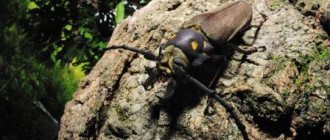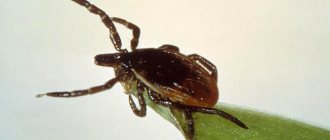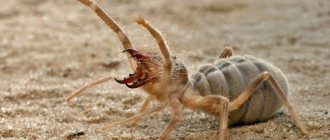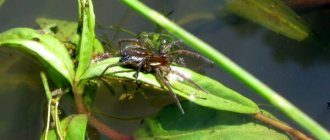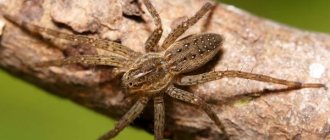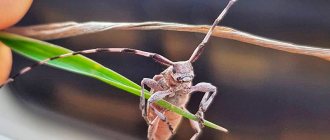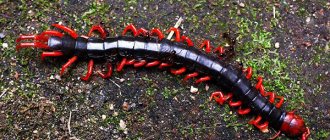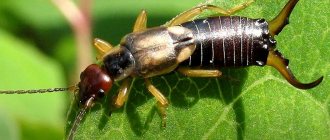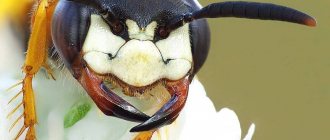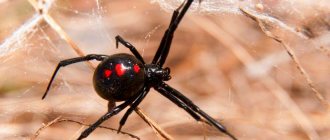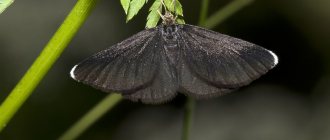Black eresus (Eresus kollari) is a poisonous spider with a unique appearance. It is also sometimes called "black fathead". This species belongs to the Eresidae family. Spider bites are dangerous for both people and pets. It is necessary to take into account that black eresus is listed in the Red Book, so killing the arachnid is strictly not recommended.
Eresus black or black fathead, appearance
Appearance of black eresus
Males reach sizes from 0.8 to 1.1 cm, females - from 1 to 1.6 cm. In rare cases, females grow up to 2 cm. The body of the spider is covered with thick hairs. The limbs are thick. Black Eresus has 8 eyes arranged in three rows.
The male's cephalothorax is black, with sparse white hairs. At the same time, there is a red border on its back. The abdomen is bright red. In its center are four round black spots, which may have a white border. The sides of the abdomen are usually black, sometimes mixed with white hair. The first two pairs of legs are covered with even white stripes. The remaining pairs of limbs are black with an admixture of red and sometimes white hair.
In females, the entire body is black. Most often, white hairs are present, which can be concentrated on both the cephalothorax and abdomen. The chelicerae and forehead area are usually yellowish-red in color. The number and length of white-yellow hairs varies depending on the subspecies.
The black eresus is called the “ladybug spider,” because the male spider is similar in color to a ladybug.
Why do they appear in an apartment or house?
There are several reasons for the appearance of spiders in a house or apartment:
- In private homes, spiders are a fairly common occurrence. They live outdoors, but often crawl indoors;
- A person can bring a spider on his clothes. Having thus entered the house, he remains to live there;
- spiders are predators. If insects live in a house or apartment (flies, cockroaches, bedbugs, mosquitoes), then even a black spider that accidentally gets into the house will remain: warm, almost safe and plenty of food.
A spider is an animal, not an insect, as many are accustomed to think. It belongs to the class Arachnida, a phylum of arthropods. It consists only of the abdomen, on which the legs grow, and the cephalothorax, where the mouthparts are located.
Lifestyle of the black fathead
The spider creates a tube from the web, the depth of which is 5-10 cm. One end of this tube goes into the ground. The diameter of such a shelter is approximately 1 cm. The end of the tube, located above the ground, is expanded and can reach 10 cm in diameter. It is covered with grass or moss and is often called the "ceiling" of the shelter. It is into this part of the web that insects and other arachnids find their way. The tube and the net are connected by a thread, so when the victim is trapped, the spider receives a signal and quickly runs out of the shelter, bites the victim, then pulls it into the hole and eats it. The black eresus throws out the remains of its prey.
The spider feeds on coleoptera, flies, butterflies, mosquitoes, millipedes, woodlice, young lizards, and scorpions. Cannibalism is possible (most often manifested by females towards males).
Reproduction
The lifespan of males is only about 8.5 months, and that of females is 1.5 years. In laboratory conditions they can live more than 2.5 years. The spider reaches puberty late - only by 1-2 years. Adult males are most active in August and September in sunny weather. They constantly migrate in search of females. Courtship with a female can last several hours; before mating, the male performs a ritual dance. If during courtship there are several males near the female, then they fight with each other.
Unlike many other spiders, male black eresus settle in the same tube with the female, feeding on prey with her and periodically mating.
A few weeks after the conception of the offspring, the female creates a cocoon from the web, where she lays eggs. One cocoon can contain up to 80 eggs. The female protects the cocoon; during the day she takes it to the sun, and at night she puts it in a hole. When the time comes for the eggs to hatch, the female weaves the entrance to the hole with a web. The emerging offspring gather around the mother's mouth, absorbing already digested food. At the same time, the female secretes an increased amount of digestive enzymes, which leads to the digestion of her organs and subsequent death. After this, the young spiders feed on the corpse of the parent.
The offspring remains to spend the winter in the cocoon created by the mother. Before full development, it goes through 7-11 molts; until the third molt, the spiders are in the mother’s hole. Once the weather warms up, the spiders disperse and begin to build their own tubes in close proximity to each other and the cocoon. As a rule, they move no more than 5-10 m from the mother’s burrow.
Reproduction
The mating season begins at the end of summer. The female waits for the male on her web and senses his approach by the vibrations of the web. After fertilization, it spins a cocoon and lays up to 250 eggs inside. He carries it with him and then leaves it in a secluded place. The young animals spend the winter in this state. Spiders are born at the end of April.
The maturation period lasts several months. During this time, the nymphs molt about 5 times, increase in size, and acquire a characteristic color. By the end of summer they become sexually mature. Caterpillars and aphids serve as food for the young.
On a note!
How adult spiders overwinter - they hide in cracks in walls, utility rooms, forest litter, tree hollows. They become active as air temperatures rise in spring.
Subspecies of black eresus
Due to their wide habitat, several subspecies have formed, which have minor differences:
- Eresus kollari bifasciatus;
- Eresus collari frontalis;
- Eresus kollari ignicomus;
- Eresus kollari latefasciatus;
- Eresus kollari tricolor.
Habitat
You can meet black eresus in Central and Southern Europe and Central Asia. The spider can also be found in central Russia, the Caucasus, the southern Urals and the southern part of Western Siberia. In the Ryazan and Tambov regions, the spider is listed in the Red Book.
This species lives in sunny and dry places. The black fathead prefers bushes; the spider can be seen in meadows, steppes, and sometimes they are found in deserts.
Lifestyle and habitat
The range of the described animals is very wide, and their widespread occurrence has made them quite famous throughout the world. The external diversity of horses depends on their habitat. Most of the species and the most interesting of them are found in the tropics.
But horses have adapted to live in a wide variety of terrestrial conditions and have populated many corners of the planet. They thrive in forests, mountains, even deserts, where they spend their lives on trees, plants, grass, rocks, soil and sand.
Such creatures are also found in temperate latitudes. Being heat-loving, they are often noticed by people at the moment when they crawl out of their hiding places and perch on the walls of buildings and other well-lit, heated places in order to heat their sides in the morning sun before starting to hunt down their prey.
Sometimes the species name can be used to judge the location of such spiders. An example of this is the hawthorn racer . Such creatures often catch the eye of a person, sitting on the tree and shrub flora mentioned in the name.
Although it is not so easy to notice them, because their color allows them to almost completely merge with their given environment. The body of the spiders itself is similar in shade to the trunks and branches, and the orange areas of the legs are in harmony with the fruits of the hawthorn. Such horses live on the Black Sea coast and in other places with a similar climate.
Tiny animals do not need the company of their own kind; they are loners. During the day, spiders are completely busy hunting, and at night they rush to hide in the cracks of rocks, trees, and buildings. This is where these eight-legged creatures tend to hide on days of bad weather, waiting for good weather and warmth.
Their bed is a cradle, independently woven from alkali spider threads. They also survive the winter in reliable shelters, from which they emerge only with the arrival of spring. These tiny spiders are incredibly brave and rarely run away at the sight of a strong opponent.
They attack and attack more often. Watching their dexterity, one cannot help but admire the supernatural abilities of these creatures. They are very mobile, run great, and the claws on their paws help them easily hold on and climb smooth vertical surfaces.
When hunting, they do not spin webs like their other eight-legged counterparts. They use their silk threads as a safety net while making dizzying jumps, the length of which exceeds their own parameters at least twenty times, or even much more.
How dangerous is black eresus for humans and pets?
Eresus, unlike many other spiders, is capable of tearing human skin by injecting poison. In this case, at the site of the bite there remains a mark from the teeth located on the chelicerae. After a bite, redness and swelling occur. The pain may persist for several days, and numbness appears in the bite area. Also, a black eresus bite often causes an allergic reaction. The main symptoms are:
- dizziness;
- nausea and vomiting;
- headache;
- dyspnea;
- tachycardia;
- increased body temperature;
- blisters around the inflamed area.
Allergies can pose a deadly threat to humans. In addition, an infection can get into the wound, which will lead to suppuration. Please note that bites to the face and neck are the most dangerous.
In rare cases, the black fathead may bite a pet. The venom of this spider is extremely dangerous for small mammals such as rats, hamsters and guinea pigs. In dogs and cats, death can be caused by an allergic reaction or repeated bites. It is also possible to develop complications, such as disruption of the liver, cardiovascular system and central nervous system.
First aid for a bite
The first step is to calm the injured person, since the bite of this spider often causes panic attacks, which only accelerate the spread of the poison throughout the body. It is best to rinse the wound with clean water and then treat it with hydrogen peroxide. After this, you need to adhere to the following action plan:
- Take an antihistamine. Injections are the most effective; tablets have a weaker and slower effect.
- If the pain is severe, you can apply a cold compress to the wound. The use of painkillers is also acceptable.
- It is necessary to drink a lot of liquid, as this will speed up the removal of poison from the body.
If an allergic reaction occurs, you should immediately call an ambulance.
Cauterizing the wound or treating it with brilliant green is unacceptable. In addition, the patient’s condition can worsen:
- attempts to suck out the poison;
- eating large amounts of food shortly after being bitten;
- applying a tourniquet (regardless of its location);
- drinking alcoholic beverages as a pain reliever.
Nutrition
The horse is nicknamed this way because, after tracking it, it jumps out at its prey and then devours it. At first, with lateral and rear vision, he records even the most insignificant movement around him. And having identified the victim, it determines with unmistakable accuracy the length of the trajectory to it.
And then, having chosen the right moment, he throws a safety thread to the place of his intended landing, jumps with lightning speed, sometimes right in the air he grabs the prey with his front paws, digs in with the chelicerae and injects poison. The injected substance, due to its special properties, dissolves the object of attack, turning it into a liquid substance, which the spider drinks with pleasure.
They feed mainly on insects. And here they are not particularly picky, they eat everything they come across, unless of course the victim is too large. Beetles, other spiders, gaping mosquitoes and flies, as well as other small animals are quite suitable for them.
But there are certain species that are capable of choosing even lizards or frogs as victims. This is not because the representatives of these species are so large, it’s just that nature has awarded the babies with sufficient courage, dexterity, outstanding hunting instinct and super abilities.
How to avoid an attack by black eresus?
Black eresus is a rare species, so the likelihood of its attack is low. Despite this, it is not recommended to wear open clothing in the habitats of this spider. When encountering a black fathead, you should avoid sudden movements and do not try to pick up the arthropod. If Eresus is on the body, you should not try to kill it, because with a high probability it will have time to bite through the skin and inject poison.
It must be taken into account that before an attack, the spider raises the first pair of limbs and opens the chelicerae, thereby trying to scare away the perceived threat.
If the spider is in the house, it is better to catch it using a glass jar. After being caught, you need to put cardboard under the jar and release the dangerous animal away from human habitation.
How is a jumping spider useful?
The jumping spider is an important element of the ecosystem; it is even called the “orderly”. The spider feeds on insects, including those dangerous to humans, as well as garden pests. At the same time, the jumping spider is not dangerous to humans and is not afraid of them, so it often settles near people’s homes and helps in pest control.
For example, jumping spiders live in Uganda, Kenya and near Lake Victoria. There they feed on female malaria mosquitoes that have drunk blood. Obviously, this helps reduce human mortality due to mosquito bites, which are carriers of dangerous diseases.
Plot recognition
The behavior of the dreamed insect influences the interpretation. Options:
- Weaving a weightless net - a serene state. If the web breaks, you will have to “patch” holes in your own budget.
- Removes the snare in a dark corner - a huge scandal will occur due to the disclosure of negative information about a partner or colleague. The person has probably been cheating, setting up, and slandering for a long time. If the misgir rolled up his creation in a visible place, then a trial would follow.
- Running swiftly through the water - you are entering a period of creative upsurge.
- Crawling along the walls, floor, ceiling - you will get carried away with a profitable enterprise.
- Flies with the wind - big easy income. Buy a lottery ticket.
- Descends directly on the dreamer - the expected news of something good.
- Sits in a closed container - a complete defeat of competitors.
- He jumped on the dreamer and scared him - a surprise of any kind.
- Pressing is a bad omen. It promises losses for financiers and entrepreneurs. For family - divorce.
- To eat a spider is to become rich thanks to your intelligence.
- To crush something intentionally harmless is to offend a friend through negligence. Accidentally - too much to say.
- To run away from an aggressive person means powerlessness in the face of a powerful enemy.
- Turn around and face danger - you will be able to cope with an influential rival.
Catching with hands or nets is profitable, but difficult.
Bite
Representatives of the order of arthropods sting. They don't actually have teeth. But fantasy gives us strange metamorphoses. Bites are recognized as bad prophecies:
- By the hand - successful machinations of enemies.
- By the finger - constant troubles will haunt you until you get rid of the envious people.
- Behind the leg - road closures.
- Bites your face or neck - you will hear a lot of bad things about yourself.
The size of the stinging pest clarifies information about upcoming events:
- Small - intriguers will ruin your nerves.
- Big - you have one enemy, but a very strong one.
- Gigantic—collision with structure. For example, the police, the court, the tax office.
If an insect bites that seemed dead, it means that you will not be able to recognize the ill-wisher in time and will reveal your secrets to him.
Tips for men, women, children
Gender and age are also useful to consider. Plots depend on the imagination, experience and maturity of the individual:
- The woman demonstrates her position on the personal front. For a lover - fear of losing a loved one. Young - conception.
- The sex of the child is indicated to a pregnant woman in the early stages. The girl is busy with weaving, the boy is busy with hunting. The picture of him crawling up a tree hints at twins.
- The young woman is told about her betrothed. Black - the groom will be wealthy, red - the age difference, which will not prevent you from becoming happy.
- The man is shown the state of affairs. A huge arthropod is a harbinger of a lucrative contract.
- The child receives a suggestion from heaven. Spiders remind you of the need to listen to your parents and give up unseemly actions.
If the baby is frightened by the vision, then it is not deciphered. It’s just that a child’s mind is preoccupied with some trouble that happened the day before.
Color interpretation
According to the rules, the most memorable details are recognized. If this turns out to be the color of the arthropod, then other prophecies need to be corrected.
Black
A dark period of life lies ahead. Opponents will strike, and friends will not be able to help.
Large and black are interpreted in various ways. Read more...
Dark
Such shades also do not bode well:
- Brown - the enemy will try to knock you out of the saddle. In esotericism, this color is responsible for self-confidence. That's what they'll try to steal.
- Gray - dark affairs, if there are any in your past, will be revealed. Otherwise, the liars will defame you.
- Burgundy - an envious woman will encroach on her lover.
Red
A sign of many dangers:
- A love adventure that doesn't end well. Catch a dangerous disease.
- A lot of red ones or with spots - involvement in an adventure.
- They multiply quickly - fire.
- Bitten on the hand - divorce for married people. A single man will contact an unfree woman. The girl is with a married man who will never leave his wife.
A young lady will have to resist the seducer if she sees a large, furry, scarlet spider.
White
An amazing light-colored arthropod is considered a wonderful omen. Gray hairs indicate profitable innovations. Interpreters made the following predictions:
- The young wife, to the delight of her husband, will soon become pregnant.
- The husband will receive a charming surprise from his significant other. This will ignite his passion with renewed vigor.
- An unmarried woman will have a luxurious wedding. The marriage will be strong and harmonious.
- An unmarried man will meet a passionate partner. A crazy romance will lead to marriage.
- The pregnant woman will safely give birth to a healthy baby.
A light gray specimen predicts beautiful offspring for young people. Quantity - the number of descendants. If there is a lot, it means that the couple is destined to become the center of a friendly society.
Bright
Unusual means light gossip. They do not cause serious harm. But when accumulated, they damage the reputation. What gossipers are talking about is judged by the paint on the back and legs:
- Yellow - condemn the tendency to sleep for long periods of time, laziness.
- Green - they are counting your money, wishing for financial losses.
- Pink - they carefully observe where the dreamer goes and with whom she communicates.
- Blue - they look for character traits worthy of public condemnation.
Multi-colored specimens indicate to girls mistakes in communicating with older women. These pose a threat to the dreamer’s good name.
